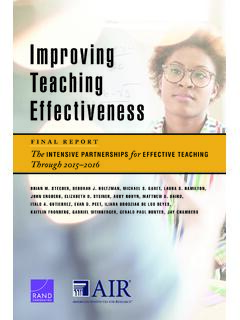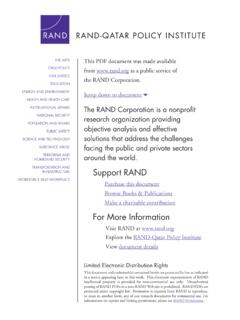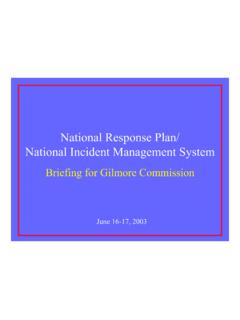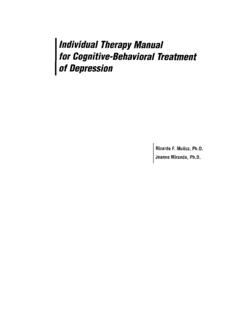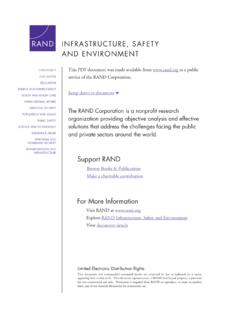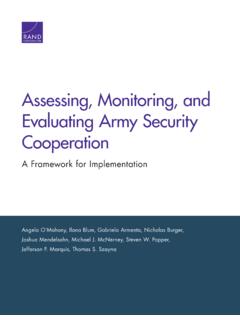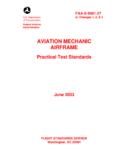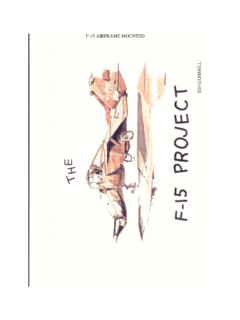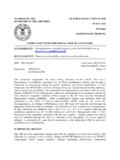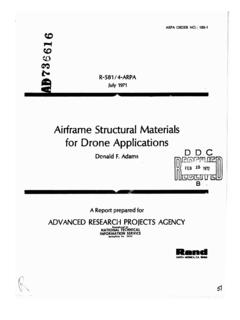Transcription of The Effects of Advanced Materials on Airframe Operating ...
1 Project AIR FORCEThe Effects of AdvancedMaterials on AirframeOperating and SupportCostsRaj Raman, John C. Graser,Obaid YounossiPrepared for theUnited States Air ForceRDOCUMENTED BRIEFINGA pproved for public release; distribution unlimitedThe research reported here was sponsored by the United States Air Force under ContractF49642-01-C-0003. Further information may be obtained from the Strategic PlanningDivision, Directorate of Plans, Hq : 0-8330-3297-6 RAND is a nonprofit institution that helps improve policy and decisionmaking throughresearch and analysis. RAND is a registered trademark. RAND s publications do notnecessarily reflect the opinions or policies of its research sponsors. Copyright 2003 RANDAll rights reserved. No part of this book may be reproduced in any form by any electronicor mechanical means (including photocopying, recording, or information storage andretrieval) without permission in writing from 2003 by RAND1700 Main Street, Box 2138, Santa Monica, CA 90407-21381200 South Hayes Street, Arlington, VA 22202-5050201 North Craig Street, Suite 202, Pittsburgh, PA 15213-1516 RAND URL: order RAND documents or to obtain additional information, contact Distribution Services: Telephone: (310) 451-7002; Fax: (310) 451-6915; Email: RAND documented briefing series is a mechanism for timely, easy-to-read reporting ofresearch that has been briefed to the client and possibly to other audiences.
2 Althoughdocumented briefings have been formally reviewed, they are not expected to becomprehensive or definitive. In many cases, they represent interim Materials particularly polymer composites and titanium are increasinglybeing used instead of aluminum in military Airframe structures because of theirsuperior strength and lighter weight. Understanding how these Advanced materialsmay affect the Operating and support costs of fielded military airframes is of criticalimportance to those making decisions on Airframe acquisitions and related choice documented briefing focuses on the Effects of Advanced Airframe Materials on theoperating and support costs of military aircraft. As such, it should be of interest to thecost analysis community, the military aircraft logistics community, and acquisitionpolicy professionals in findings reported here are from research conducted as part of a larger projectentitled The Cost of Future Military Aircraft: Historical Cost-Estimating Relationshipsand Cost-Reduction Initiatives.
3 The principal goal of this project is to improve the toolsavailable for estimating the cost of future weapon study was conducted within the Resource Management Program of RAND's ProjectAIR FORCE and was sponsored by Lieutenant General Stephen B. Plummer, PrincipalDeputy Assistant Secretary of the Air Force (Acquisition). The technical points ofcontact were Jay Jordan, current technical director of the Air Force Cost AnalysisAgency (AFCAA), and B. J. White-Olson, technical director of the AFCAA at the time ofthis study. The data used in this briefing were drawn from databases maintained by theAir Force Cost Analysis Agency, Air Force Materiel Command, Naval Center for CostAnalysis, and the Naval Aviation Logistics Data Analysis Group. Data presented in thisbriefing are current as of November publications that report on the results of RAND s ongoing research in the area ofmilitary Airframe cost-estimating include the following:xAircraft Airframe Cost-Estimating Relationships: Study Approach and Conclusions by Hess and H.
4 P. Romanoff, R-3255-AF, 1987xAdvanced Airframe Structural Materials : A Primer and Cost-Estimating Methodology bySusan A. Resetar, J. Curt Rogers, and Ronald Wayne Hess,R-4016-AF, 1991xMilitary Airframe Costs: The Effects of Advanced Materials and Manufacturing Processesby Obaid Younossi, Michael Kennedy, and John C. Graser, MR-1370-AF, 2001xMilitary Airframe Acquisition Costs: The Effects of Lean Manufacturing by Cynthia and John C. Graser, MR-1325-AF, 2001xAn Overview of Acquisition Reform Cost Savings Estimates by Mark A. Lorell and JohnC. Graser, MR-1329-AF, PROJECT AIR FORCEP roject AIR FORCE, a division of RAND, is the Air Force federally funded researchand development center for studies and analysis. It provides the Air Force withindependent analyses of policy alternatives affecting the development, employment,combat readiness, and support of current and future aerospace forces.
5 Research isperformed within four programs: Aerospace Force Development; Manpower,Personnel, and Training; Resource Management; and Strategy and and 11. 52. B-2 Program Office Airframe Contractor F/A-18 Part-Level Estimating Future Study A: Aircraft Operating and Support CostElement B: Airframe Material-Specific MaintenanceCosts in Depot C: Database Sources for Airframe O&S Materials particularly polymer composites and titanium are increasinglybeing used in the airframes of high-performance military aircraft. With that in mind,this study concentrates on answering a fundamental question: Do Advanced airframematerials cost more to maintain than aluminum, which has historically been the mostcommon material used in Airframe structures?Although considerable effort has been devoted to understanding the acquisition costs ofadvanced Materials , very little is known about their Operating and support (O&S) costsafter an aircraft is fielded and fully , 2 In an effort to gain a betterunderstanding of Advanced -material O&S costs, we produced a methodology forforecasting those costs, which we present in this documented assess the Effects of Advanced Materials on Airframe O&S costs, we analyzedF/A-18 A/B/C/D part-level data3 and surveyed individuals in both the governmentand in approach for this study focuses on the development of material-weighting factorsfor the relative cost of maintaining Airframe structural parts made of advancedmaterials.
6 Maintenance data for aluminum parts served as the baseline. We estimatedthe material-weighting factors from historical base-level maintenance data forF/A-18 A/B/C/D Airframe structural parts and from survey information providedby the Air Force s B-2 Program Office and by five major Airframe restricted our study to Airframe skins, access covers, and access doors because theseairframe parts have proven to be those most susceptible to damage. We developedmaterial-weighting factors for titanium parts and for composite parts with and without1 This study did not attempt to compare Operating and support costs across services due to their inherentaccounting We did not address the impact of stealth technology on Airframe costs because of the highly classifiednature of the information on that technology. Thus, our report does not consider maintenance costs ofstealthy aircraft, other than the basic costs of using various polymer composite parts without any stealth-related Materials such as Visibility and Management of Operating and Support Costs (VAMOSC) and Equipment ConditionAnalysis (ECA) databases were used as data sources.
7 The VAMOSC database is maintained by the NavalCenter for Cost Analysis (NCCA), and the ECA database is maintained by Naval Aviation Logistics DataAnalysis (NALDA), a group supported by NAVAIR Logistics. See Appendix C for further informationon these honeycomb substructures,4 again using aluminum parts as the baseline. Wethen applied these cost weighting factors to quantify the relative difference in materialproperties, leading to a change in maintenance requirements and related costs, oftitanium and composite parts compared with an all-aluminum FINDINGSS enior-level decisionmakers in the Department of Defense should not be concernedabout the use of Advanced Materials in military aircraft in terms of significantdownstream Operating and support costs. Structural Materials drive only about 5percent of the total O&S costs of maintaining airframes of military aircraft (these costsoccur almost exclusively at the depot level).
8 Thus, even if composites and titaniummaterials constitute a larger percentage of the Airframe composition, the net change intotal O&S costs should be negligible compared with the projected total O&S costs for atheoretical, all-aluminum fighter aircraft. This change does not take into account thebenefits gained from the weight savings from those generally lighter-weight higher-strength Materials . A key example is the cost savings resulting from reduction in fuelconsumption due to decreased weight. In general, both composites and titanium aremore expensive to repair than aluminum; however, titanium is more resistant todamage than either composites or Materials are used on an aircraft is far more important than their composition, asfar as O&S costs go. Areas of an aircraft in which continual access by maintenancepersonnel is required have higher costs attached to them than those that requireinfrequent maintenance access.
9 Thus, greater reliability of working parts in the airframeor avionics systems obviates the need for access to those parts, thus reducingmaintenance costs regardless of material following findings should be useful to cost analysts and aircraft designers whohave responsibility for analyzing the costs of available choices for Materials inairframes:xThe F/A-18 part-level analysis indicates that the amount of maintenance is afunction of part type. Of the three types of parts we investigated, access doorsare the most expensive to from the F/A-18 part-level analysis and from the B-2 Program Officesurvey indicate that composite Materials require more maintenance thanaluminum, with composite parts containing aluminum honeycomb substructuresrequiring the most maintenance. The results from our survey of airframe4 Composite parts include sheet configurations, such as graphite epoxy sheets, and multilayeredconfigurations with graphite epoxy sheets and aluminum honeycomb substructures.
10 The sheetconfiguration has been used in Airframe skins and some types of access covers, while the mulitlayeredconfiguration has been used in access doors and certain other types of access covers. For this reason, wecompared composite parts with aluminum honeycomb substructures (multilayered configuration) andwithout the substructures (sheet configuration).ixcontractors reinforce these conclusions about the maintenance requirements ofcomposite the case of titanium, the F/A-18 and B-2 Program Office analyses wereconsistent in concluding that simple parts made of titanium sheets require lesslabor and cost less in consumable Materials than those made of , results from the five major Airframe contractors we surveyed indicatethat superplastic-formed/diffusion-bonded (SPF/DB) and cast-titanium partsvary in their maintenance requirements as compared with aluminum, whichsuggests a link between material form and maintenance material-weighting factors we developed depend strongly on part type.
